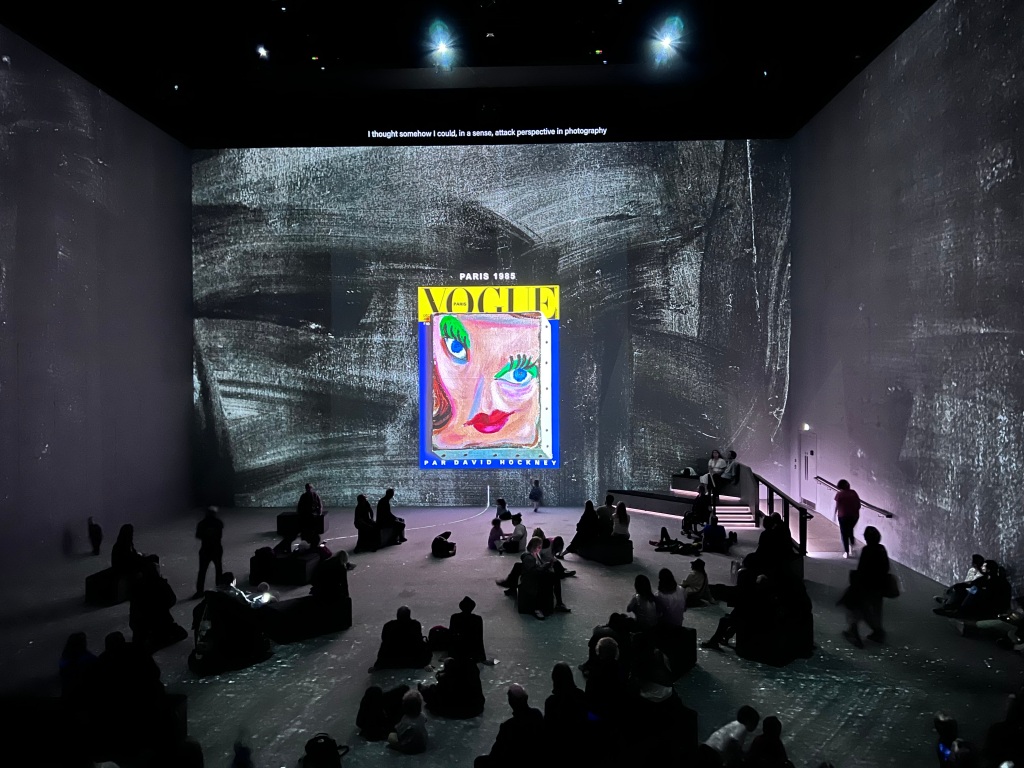Since late February, David Hockney: Bigger & Closer (not smaller & further away) has taken over Kings Cross’ Lightroom. But in a city brimming with immersive art EXPERIENCES, is this one expendable, or does it possess a more profound significance?
London is renowned for its vibrant art scene, and more recently, immersive art exhibitions have become a trend within the city’s cultural landscape.
These innovative digital spectacles offer visitors a dynamic and sensory-rich experience that transcends traditional art encounters, sometimes reimagining or reinterpreting famous works, and other times, creating new experiences all together. They blur the lines between reality and imagination, and often experiment with technology, art, theatre, film and music to create multi-disciplinary projects that have the ability to captivate a much wider audience; cultivating a dynamic fusion that pushes boundaries to unlock new realms of artistic expression by mixing arts disciplines to enrich creativity and to foster unique perspectives and innovative ideas.

But walking through mesmerising light displays, stepping into reimagined historical eras, and listening to sounds in ways you never thought possible is becoming so frequent, are venues becoming overly saturated with immersive art? And is this surge nothing more than a reflection on society’s craving for a novel sensory experience for social media?
I knew of Hockney’s work since childhood but it wasn’t until much later in my art studies that I realised just how fond of his work I was; and it wasn’t until my mid-twenties when I truly realised that Hockney’s work was informing many of my own creative decisions in work. Therefore one might assume that a Hockney exhibition that plays with light, sound and technology—all areas I work with— would spark an interest, but instead, it made me far more apprehensive. I’d been battling with the idea of going to the exhibition since its opening but my mind was fraught with dilemma. But, on a Saturday afternoon—around five months after Hockney’s exhibition opened at London’s Lightroom, I headed to Kings Cross in the pouring rain and with my ticket purchased only the night before.

I’ll admit that on entering the building, I wasn’t sure what to expect despite having read reviews, but relatively quickly I had made up my own mind. If anything, this wasn’t an exhibition at all, but more so, a beautifully illustrated documentary which places the audience inside the work and at the centre of Hockney’s world.
Sat, laying or standing for around 50 minutes, you’re taken on a journey through the creativity, life and work of one of the world’s most prominent artists in this collaboration with London Theatre Company and 59 Productions.

Screens serve as canvases as projections envelope the audience whilst Hockney’s narration emphasises the significance of careful observation. Hockney details his life and work through chapters served alongside iconic works, those lesser-known works, his artistic experimentations, and at times, an art history lesson with a detailed insight into some of Hockney’s theatrical collaborations.
Celebrated for his innovative approach to art, Hockney’s vibrant use of colour, exploration of perspective and mastery of various mediums have left an indelible mark on the art world.
From iconic swimming pool paintings to digital creations, continuously redefining artistic boundaries, the large and seemingly bland space becomes vivid and lively. Set to an original score by Nico Muhly, 3D scanning and multicameras help form these 2D works into something almost tangible and admirable, but never frivolous.

It becomes almost unwise to suggest that this is an immersive exhibition in the same way that Frameless, for example, has been considered to be. Bigger & Closer (Not Smaller & Further Away) is more of a cinematic experience that is perhaps advertised with the wrong terminology and as a consequence, the space draws in crowds, many of which with children under the assumption that it’s an artistic playground, which of course, becomes rather distracting to those wanting to watch, listen and engage.
Such events often draw diverse audiences, including art enthusiasts, families, and those seeking unique forms of entertainment and foster a breeding ground for creative and technological experimentation. It’s therefore no surprise that immersive art exhibitions have grown significantly over the past few years, with early versions entering prominence around the early 2000s. But it is these past few years where new technologies, curious audiences and a desire for interactivity have inevitably seen digital experiences across the arts including Superblue Miami, Mexican Geniuses, teamLab Planets TOKYO, Moonbathing and many more, cover cities worldwide.
While they do provide creative platforms, saturation does risk diluting impact and it feels like in the case of Bigger & Closer (Not Smaller & Further Away), a little misinterpretation is at play.
Balancing innovation with substance ensures meaningful engagement, whilst preserving the integrity and impact of immersive art for both artists and audiences should be key. In many cases it does. And as these immersive showcases continue to captivate and inspire, they undoubtedly contribute to, in this case, London’s reputation as a global hub for artistic innovation and cultural exploration.
Indeed, these exhibits serve to expand artists’ reach and introduce them to fresh audiences. In that regard, it can hardly be perceived as a negative outcome at all, can it?